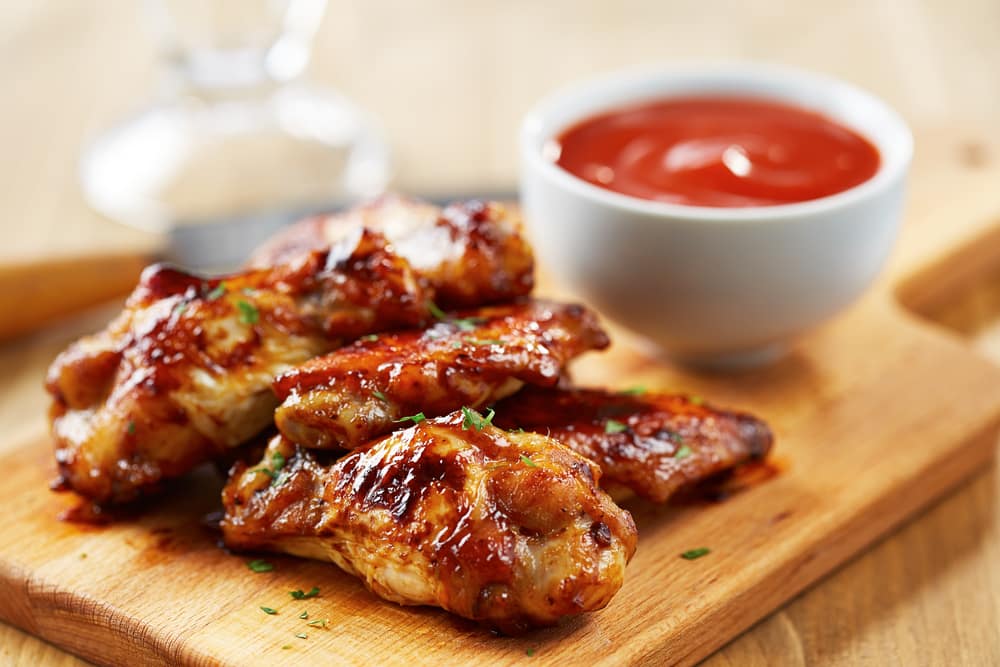
Chicken wings
Created by a woman named Teressa Bellissimo in the year 1964. The buffalo chicken wing is an American invention, now popular throughout the entire world.
Served as an appetizer, the buffalo chicken wing is a spicy, sauce-covered, sticky chicken wing that has a deep smoky flavor.
A buffalo chicken wing is composed of three things, a dry chicken wing, a spice rub or breading, and a spicy, sticky coating sauce.
When cooking a batch of buffalo chicken wings, the first step is breading your chicken wings or rubbing them with a spice mix. Next comes frying or baking and the last step is coating your chicken wings with a spicy buffalo sauce. The last step is also the most difficult step to perfect. Because most of the time, you’ll end up cooking a batch of sparsely coated buffalo chicken wings.
How Do You Get Sauce To Stick To Wings?
How to get the sauce to stick?
Everybody hates a runny sauce, it’s messy, less flavorful, and a disaster if you’re wearing a light-color shirt. To help you avoid such misery, we have compiled a few cooking tips that will make your sauce stick to the chicken wings.
To make your sauce stick to the chicken wings, you’ll need to perfect two things, a crispy skin, and a sticky sauce.
Crispy skin
A crispy skin will absorb more sauce than a slimy, gooey, tender skin. Whether you are baking or frying, cooking your chicken wings on high heat results in a crisper skin. The perfect oven temperature is 425 degrees Fahrenheit, whereas the perfect frying temperature is 375 degrees Fahrenheit.
Just cooking on high heat is not enough, for perfect results you’ll need to add additional ingredients. Cornstarch when frying and baking soda when baking.
- Cornstarch
Coating your chicken wings with a light flour mixture may or may not result in a crisper skin. But why flour when there is a better alternative called cornstarch. Unlike flour which is part starch and part gluten, cornstarch is one hundred percent starch. Meaning cornstarch absorbs less moisture and fat, so instead of using flour only mixture, using a half flour half cornstarch breading mixture results in a crisper, less greasy chicken wing. The type of chicken wing that absorbs more sauce.
- Baking soda
Cornstarch is used when frying and baking soda when baking. Baking soda is an alkaline cooking ingredient that has a high pH value. When added to the spice rub, baking soda’s alkaline nature breaks the peptide bonds present inside the skin of a chicken wing. So chicken wings covered in baking soda, when baked, always have a crisper, more dryer skin. The type of skin that absorbs more sauce.
Unlike cornstarch, baking soda is acidic. So we advise you to use half a teaspoon of baking soda for three pounds of chicken wings. Because baking soda when used excessively imparts an unpleasant acidic flavor to your chicken wings.
Sticky sauce
A sticky sauce, as the name implies, sticks to your chicken wings. There are two ways to convert your runny sauce into a sticky sauce.
- Eliminate excess moisture
If your sauce is watery, reduce it inside an uncovered pot. After reducing, it’s essential to let the sauce cool down before adding the chicken wings.
- Honey
Honey is inherently sticky, so adding it to your sauce makes it sticky as well. But it’s extremely important to eliminate excess moisture before adding a few tablespoons of honey.